
| Home | Table of contents | Keys | Species list | Glossary | Image data | PDF | Cite this article | Feedback | Updates |
Identification Atlas of the Vespidae (Hymenoptera, Aculeata) of the northeastern Nearctic region
CJAI 05, February 19, 2008
doi: 10.3752/cjai.2008.05
Matthias Buck, Stephen A. Marshall, and David K.B. Cheung
Department of Environmental Biology, University of Guelph, Guelph, Ontario, Canada N1G 2W1
Next species | Previous species | Key
96. Vespula squamosa (Drury, 1773) – Southern Yellowjacket
Figs B13.1, 32, 56, 67; C96.1–10.
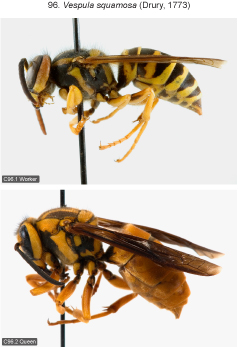 |
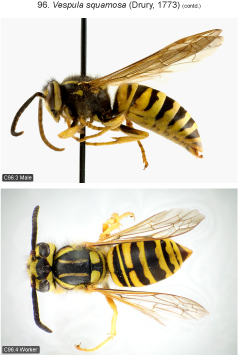 |
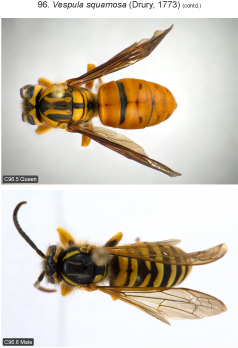 |
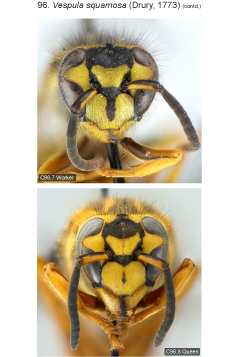 |
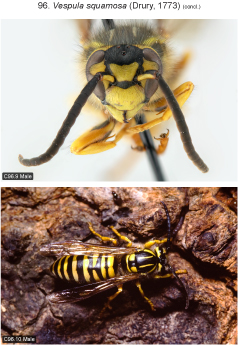 |
Species recognition. This is the most distinctive yellowjacket species in the east. All castes show a pair of long longitudinal stripes on the scutum, unique among eastern species. The queen is characterized by a strong reduction of black markings on the metasoma, leaving only pairs of discal spots (often indistinct) and black basal areas on tergum 1 (restricted to vertical, anterior surface) and tergum 2. The metasomal pattern of the very dissimilar worker and male is also unique: it includes an additional, medially interrupted, discal fascia on tergum 2.
Variation. Fore wing length 9.5–11.0 mm (workers), 15.0–16.5 mm (♀♀), ca. 12.5 mm (♂♂, n = 2). Yellow markings of queen slightly suffused with orange, especially on metasoma. Clypeus with or without a small black central spot in queen, rarely more elongate and somewhat extended dorsally; clypeal mark more or less parallel-sided and extending to dorsal margin of clypeus in worker; black markings absent in male. Black band between corona and ocular sinus often interrupted in queen, narrow in worker, broad in male. Yellow eye-loop broadly interrupted at summit of eye in male, sometimes narrowly interrupted in worker. Elongate spots of scutum sometimes more or less connected to each other just before middle and/or posteriorly in queen. Pronotal lobes usually more or less marked with yellow in female. Queen with yellow scutal spots opposite tegula; rarely present in worker. Yellow band of metanotum complete, sometimes narrowly interrupted in male. Mesopleuron with an elongate yellow spot from pronotal lobe to mid coxa; in male reduced to dorsal and ventral spots. Propodeum with large yellow markings in female, with or without small markings in male. Pattern of metasoma fairly uniform; in queen pairs of discal spots on terga 2–5 and medial spot of tergum 2 usually more or less evanescent.
Distribution. Canada: adventitious in southern ON (one record). Eastern U.S.: NY to FL, west to WI, IA, NE, KS, OK and TX. Mexico: Tamaulipas south to Michoacán and Chiapas. Also in Guatemala and Honduras (Carpenter and Kojima 1997).
Biology. This species shows facultative social parasitism of other yellowjackets, especially V. maculifrons and rarely V. vidua. In the United States up to 80% of V. squamosa nests result from nest usurpations of other species. Like those of its preferred host, the nests of V. squamosa are mostly subterranean but aerial nests are not uncommon in urban settings where they are usually found in hollow walls. Workers prey on live arthropods and scavenge on carrion. In the southeastern U.S. V. squamosa is an important nuisance species because of its preference for disturbed areas, resulting in frequent contact with humans (Akre et al. 1981).
Next species | Previous species | Key
| Home | Table of contents | Keys | Species list | Glossary | Image data | PDF | Cite this article | Feedback | Updates |
